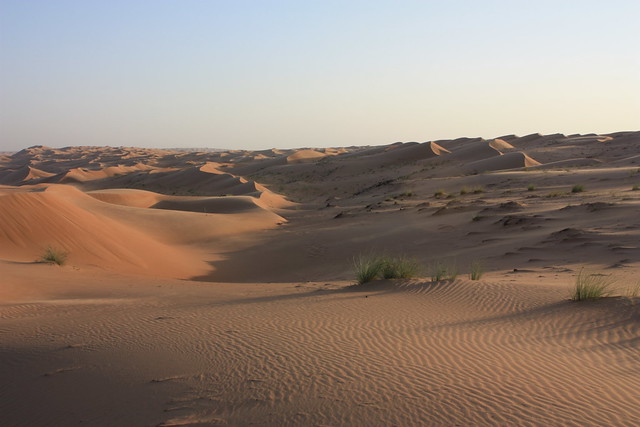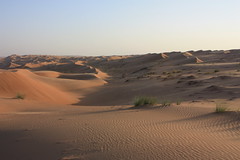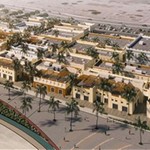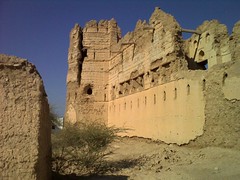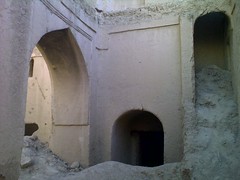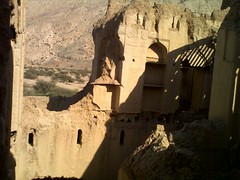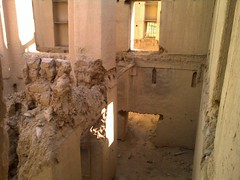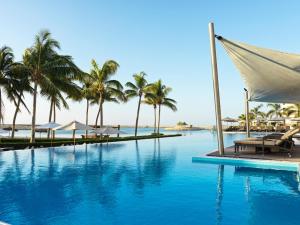 Oman
Oman
Oman (English: /ˈmn/ ; Arabic: عُمَان, Arabic: [ʕʊˈmaːn]), officially the Sultanate of Oman (Arabic: سلْطنةُ عُمان), is a country located in Western Asia. It is situated on the southeastern coast of the Arabian Peninsula, and spans the mouth of the Persian Gulf. Oman shares land borders with Saudi Arabia, the United Arab Emirates, and Yemen, while sharing maritime borders with Iran and Pakistan. Oman has a population of 5,492,196 and is ranked the 120th most Populous country in the world.
The coast is formed by the Arabian Sea on the southeast, and the Gulf of Oman on the northeast. The Madha and Musandam exclaves are surrounded by the United Arab Emirates on their land borders, with the Strait of Hormuz (which it shares with Iran) and the Gulf of Oman forming Musandam's coastal boundaries. Muscat is the nation's capital and largest city.
From the 17th century, the Omani Sultanate was an empire, vying with the Portuguese and British empires for influence in the Persian Gulf and Indian Ocean. At its peak in the 19th century, Omani influence and control extended across the Strait of Hormuz to Iran and Pakistan, and as far south as Zanzibar. When its power declined in the 20th century, the sultanate came under the influence of the United Kingdom. For over 300 years, the relations built between the two empires were based on mutual benefit. The UK recognized Oman's geographical importance as a trading hub that secured their trading lanes in the Persian Gulf and Indian Ocean and protected their empire in the Indian sub-continent. Historically, Muscat was the principal trading port of the Persian Gulf region.
Oman is an absolute monarchy led by a Sultan, with power passed down through the male line. Qaboos bin Said was the Sultan from 1970 until his death on 10 January 2020. Qaboos bin Said, who died childless, had named his cousin, Haitham bin Tariq, as his successor in a letter, and the family confirmed him as the new Sultan of Oman.
Formerly a maritime empire, Oman is the oldest continuously independent state in the Arab world. It is a member of the United Nations, the Arab League, the Gulf Cooperation Council, the Non-Aligned Movement and the Organisation of Islamic Cooperation. It has oil reserves ranked 22nd globally. In 2010, the United Nations Development Programme ranked Oman as the most improved nation in the world in terms of development during the preceding 40 years. A portion of its economy involves tourism and trading fish, dates and other agricultural produce. Oman is categorized as a high-income economy and, , ranks as the 64th most peaceful country in the world according to the Global Peace Index.
Etymology
The origin of Oman's name seems to be related to Pliny the Elder's Omana and Ptolemy's Omanon (in Greek), both probably the ancient Sohar. The city or region is typically etymologized in Arabic from aamen or amoun ("settled" people, as opposed to the Bedouin). Although a number of eponymous founders have been proposed (Oman bin Ibrahim al-Khalil, Oman bin Siba' bin Yaghthan bin Ibrahim, Oman bin Qahtan and the Biblical Lot), others derive it from the name of a valley in Yemen at Ma'rib presumed to have been the origin of the city's founders, the Azd, a tribe migrating from Yemen.
History
Prehistory and ancient history
At Aybut Al Auwal, in the Dhofar Governorate of Oman, a site was discovered in 2011 containing more than 100 surface scatters of stone tools, belonging to a regionally specific African lithic industry—the late Nubian Complex—known previously only from the northeast and Horn of Africa. Two optically stimulated luminescence age estimates place the Arabian Nubian Complex at 106,000 years old. This supports the proposition that early human populations moved from Africa into Arabia during the Late Pleistocene.
In recent years surveys have uncovered Palaeolithic and Neolithic sites on the eastern coast. Main Palaeolithic sites include Saiwan-Ghunaim in the Barr al-Hikman. Archaeological remains are particularly numerous for the Bronze Age Umm an-Nar and Wadi Suq periods. Sites such as Bat show professional wheel-turned pottery, excellent hand-made stone vessels, a metals industry and monumental architecture . The Early (1300‒300 BCE) and Late Iron Ages (100 BCE‒300 CE) show more differences than similarities to each other. Thereafter, until the coming of Ibadi Islam, little or nothing is known.
There is considerable agreement in sources that frankincense was used by traders in 1500 BCE. The Land of Frankincense, a UNESCO World Heritage site, dramatically illustrates that the incense constituted testimony to South Arabian civilizations.
During the 8th century BCE, it is believed that the Yaarub, the descendant of Qahtan, ruled the entire region of Yemen, including Oman. Wathil bin Himyar bin Abd-Shams (Saba) bin Yashjub (Yaman) bin Yarub bin Qahtan later ruled Oman. It is thus believed that the Yaarubah were the first settlers in Oman from Yemen.
In the 1970s and 1980s scholars like John C. Wilkinson believed by virtue of oral history that in the 6th century BCE, the Achaemenids exerted control over the Omani peninsula, most likely ruling from a coastal centre such as Suhar. Central Oman has its own indigenous Samad Late Iron Age cultural assemblage named eponymously from Samad al-Shan. In the northern part of the Oman Peninsula the Recent Pre-Islamic Period begins in the 3rd century BCE and extends into the 3rd century CE. Whether or not Persians brought south-eastern Arabian under their control is a moot point, since the lack of Persian finds speak against this belief. M. Caussin de Percevel suggests that Shammir bin Wathil bin Himyar recognized the authority of Cyrus the Great over Oman in 536 BCE.
Sumerian tablets referred to Oman as "Magan" and in the Akkadian language "Makan", a name which links Oman's ancient copper resources. Mazoon, a Persian name used to refer to Oman's region, which was part of the Sasanian Empire.
Arab settlement
Over centuries tribes from western Arabia settled in Oman, making a living by fishing, farming, herding or stock breeding, and many present day Omani families trace their ancestral roots to other parts of Arabia. Arab migration to Oman started from northern-western and south-western Arabia and those who chose to settle had to compete with the indigenous population for the best arable land. When Arab tribes started to migrate to Oman, there were two distinct groups. One group, a segment of the Azd tribe migrated from Yemen in A.D. 120/200 following the collapse of Marib Dam, while the other group migrated a few centuries before the birth of Islam from Nejd (present-day Saudi Arabia), named Nizari. Other historians believe that the Yaarubah from Qahtan which belong to an older branch, were the first settlers of Oman from Yemen, and then came the Azd.
The Azd settlers in Oman are descendants of Nasr bin Azd and were later known as "the Al-Azd of Oman". Seventy years after the first Azd migration, another branch of Alazdi under Malik bin Fahm, the founder of Kingdom of Tanukhites on the west of Euphrates, is believed to have settled in Oman. According to Al-Kalbi, Malik bin Fahm was the first settler of Alazd. He is said to have first settled in Qalhat. By this account, Malik, with an armed force of more than 6000 men and horses, fought against the Marzban, who served an ambiguously named Persian king in the battle of Salut in Oman and eventually defeated the Persian forces. This account is, however, semi-legendary and seems to condense multiple centuries of migration and conflict into a story of two campaigns that exaggerate the success of the Arabs. The account may also represent an amalgamation of various traditions from not only the Arab tribes but also the region's original inhabitants. Furthermore, no date can be determined for the events of this story.
In the 7th century CE, Omanis came in contact with and accepted Islam. The conversion of Omanis to Islam is ascribed to Amr ibn al-As, who was sent by the prophet Muhammad during the Expedition of Zaid ibn Haritha (Hisma). Amer was dispatched to meet with Jaifer and Abd, the sons of Julanda who ruled Oman. They appear to have readily embraced Islam.
Imamate of Oman
Omani Azd used to travel to Basra for trade, which was a centre of Islam, during the Umayyad empire. Omani Azd were granted a section of Basra, where they could settle and attend to their needs. Many of the Omani Azd who settled in Basra became wealthy merchants and, under their leader Muhallab bin Abi Sufrah, started to expand their influence of power eastwards towards Khorasan. Ibadhi Islam originated in Basra through its founder, Abdullah ibn Ibadh, around the year 650 CE; the Omani Azd in Iraq would subsequently adopt this as their predominant faith. Later, Al-hajjaj, the governor of Iraq, came into conflict with the Ibadhis, which forced them back to Oman. Among those who returned was the scholar Jaber bin Zaid. His return (and the return of many other scholars) greatly enhanced the Ibadhi movement in Oman. Alhajjaj also made an attempt to subjugate Oman, then ruled by Suleiman and Said (the sons of Abbad bin Julanda). Alhajjaj dispatched Mujjaah bin Shiwah, who was confronted by Said bin Abbad. This confrontation devastated Said's army, after which he and his forces retreated to the Jebel Akhdar (mountains). Mujjaah and his forces went after Said, successfully flushing them out from hiding in Wadi Mastall. Mujjaah later moved towards the coast, where he confronted Suleiman bin Abbad. The battle was won by Suleiman's forces. Alhajjaj, however, sent another force (under Abdulrahman bin Suleiman); he eventually won the war, taking over the governance of Oman.
The first elective Imamate of Oman is believed to have been established shortly after the fall of the Umayyad Dynasty in 750/755 AD, when Janaħ bin ʕibadah Alħinnawi was elected. Other scholars claim that Janaħ bin Ibadah served as a Wāli (governor) under the Umayyad dynasty (and later ratified t…
Hotels Oman
Looking for places related to Oman?
Those are other destinations to find places related to Oman:
